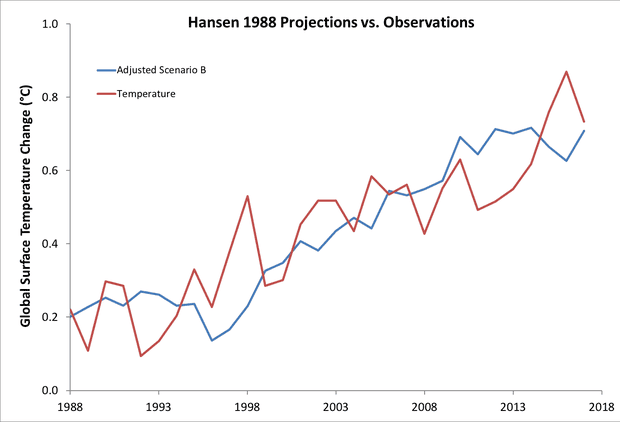
30 years ago, James Hansen testified to Congress about the dangers of human-caused climate change. In his testimony, Hansen showed the results of his 1988 study using a climate model to project future global warming under three possible scenarios, ranging from ‘business as usual’ heavy pollution in his Scenario A to ‘draconian emissions cuts’ in Scenario C, with a moderate Scenario B in between.
Changes in the human effects that influence Earth’s global energy imbalance (a.k.a. ‘anthropogenic radiative forcings’) have in reality been closest to Hansen’s Scenario B, but about 20–30% weaker thanks to the success of the Montreal Protocol in phasing out chlorofluorocarbons (CFCs). Hansen’s climate model projected that under Scenario B, global surface air temperatures would warm about 0.84°C between 1988 and 2017. But with a global energy imbalance 20–30% lower, it would have predicted a global surface warming closer to 0.6–0.7°C by this year.
The actual 1988–2017 temperature increase was about 0.6°C. Hansen’s 1988 global climate model was almost spot-on.

Scenario B from Hansen’s 1988 paper, with the trend reduced by 27% to reflect the actual radiative forcing from 1984 to 2017, compared to global surface temperature data from Cowtan & Way. Illustration: Dana Nuccitelli
The incredible accuracy of Hansen’s climate model predictions debunks a number of climate denier myths. It shows that climate models are accurate and reliable, that global warming is proceeding as climate scientists predicted, and thus that we should probably start listening to them and take action to address the existential threat it poses.
Hansen’s predictions have thus become a target of climate denier misinformation. It began way back in 1998, when the Cato Institute’s Patrick Michaels – who has admitted that something like 40% of his salary comes from the fossil fuel industry – arguably committed perjury in testimony to Congress. Invited by Republicans to testify as the Kyoto Protocol climate agreement was in the works, Michaels was asked to evaluate how Hansen’s predictions were faring 10 years later.
In his presentation, Michaels deleted Hansen’s Scenarios B and C – the ones closest to reality – and only showed Scenario A to make it seem as though Hansen had drastically over-predicted global warming. Deleting inconvenient data in order to fool his audience became a habit for Patrick Michaels, who quickly earned a reputation of dishonesty in the climate science world, but has nevertheless remained a favorite of oil industry and conservative media.
Last week in the Wall Street Journal, Michaels was joined by Ryan Maue in an op-ed that again grossly distorted Hansen’s 1988 paper. Maue is a young scientist with a contrarian streak who’s published some serious research on hurricanes, but since joining the Cato Institute last year, seems to have sold off his remaining credibility to the fossil fuel industry.
In their WSJ opinion piece, Michaels and Maue claimed:
Global surface temperature has not increased significantly since 2000, discounting the larger-than-usual El Niño of 2015-16. Assessed by Mr. Hansen’s model, surface temperatures are behaving as if we had capped 18 years ago the carbon-dioxide emissions responsible for the enhanced greenhouse effect.
They provided no evidence to support this claim (evidence and facts seem not to be allowed on the WSJ Opinion page), and it takes just 30 seconds to fact check. In reality, global surface temperatures have increased by about 0.35°C since 2000 – precisely in line with Hansen’s 1988 model projections, as shown above. And it’s unscientific to simply “discount” the El Niño of 2015-16, because between the years 1999 and 2014, seven were cooled by La Niña events while just four experienced an El Niño warming. Yet despite the preponderance of La Niña events, global surface temperatures still warmed 0.15°C during that time. There’s simply not an ounce of truth to Michaels’ and Maue’s central WSJ claim.
It’s also worth noting that Hansen’s 1988 paper accurately predicted the geographic pattern of global warming, with the Arctic region warming fastest and more warming over land masses than the oceans. And climate deniers in the 1980s like Richard Lindzen were predicting “that the likelihood over the next century of greenhouse warming reaching magnitudes comparable to natural variability seems small.” If anyone deserves criticism for inaccurate climate predictions, it’s deniers like Lindzen who thought there wouldn’t be any significant warming, when in reality we’ve seen the dramatic global warming that James Hansen predicted.
Michaels’ and Maue’s misinformation didn’t stop there:
And it isn’t just Mr. Hansen who got it wrong. Models devised by the United Nations Intergovernmental Panel on Climate Change have, on average, predicted about twice as much warming as has been observed since global satellite temperature monitoring began 40 years ago.
Once again, this unsupported assertion is completely wrong. I evaluated the IPCC’s global warming projections in my book, and showed in detail that theirs have been among the most accurate predictions. The climate model temperature projections in the 1990, 1995, 2001, and 2007 IPCC reports were all remarkably accurate; the IPCC predicted global warming almost exactly right.
Posted by dana1981 on Monday, 25 June, 2018
 |
The Skeptical Science website by Skeptical Science is licensed under a Creative Commons Attribution 3.0 Unported License. |